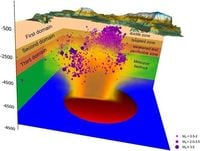In a significant update regarding the Campi Flegrei volcanic complex, the National Institute of Geophysics and Volcanology (INGV) has released its latest monthly report, revealing a decrease in both seismic activity and ground uplift rates. This report, published on May 7, 2025, highlights a notable shift in the monitoring of one of Europe’s most closely watched volcanic systems.
According to the report, the Campi Flegrei experienced 476 recorded earthquakes in the last month, with the most powerful reaching a magnitude of 2.9. This marks a substantial decline from the previous month, which recorded 659 earthquakes. The seismic events were primarily concentrated around areas such as Pozzuoli, Agnano, the Solfatara-Pisciarelli region, Bagnoli, and the Gulf of Pozzuoli.
In addition to the reduction in seismic activity, the report indicates a slowdown in the rate of ground uplift. Since early April 2025, the average uplift has been approximately 15 millimeters per month, a significant decrease from the 30 millimeters observed at the end of March. Overall, since November 2005, the total uplift has reached 1.45 meters, with about 27 centimeters occurring since January 2024 and just 2 centimeters in the last month.
The report also details temperature changes in the Pisciarelli area, noting a "significant increase in the first part of the month followed by a stabilization at values about 10 degrees higher than those recorded in previous months." Contrarily, in the Agnano-via Antiniana area, there was a slight decrease in temperature values, accompanied by minor fluctuations.
Despite these changes, the INGV report assures that there are currently no indicators suggesting significant short-term developments in volcanic activity. The monitoring status of the Phlegraean area remains at a "yellow" alert level, indicating a need for continued observation but no immediate cause for alarm.
In a related study, also released on May 7, 2025, researchers from the INGV have identified a fragile layer located at a depth of 3 to 4 kilometers beneath the Campi Flegrei caldera. This groundbreaking research, published in AGU Advances, is based on analyses of rock samples collected from a geothermal well that reaches 3 kilometers deep.
The study reveals a clear transition at around 2.5 to 2.7 kilometers in depth, where the crust becomes more porous and permeable. This increased porosity reduces the resistance of the area, allowing for the accumulation of magmatic fluids. Numerical simulations conducted as part of the research indicate that many magma intrusions cease at this depth, leading to ground deformations and recurrent seismic activity.
The existence of this "weak layer" appears to facilitate processes of aborted eruptions, where magma intrusions do not reach the surface. This finding is crucial for understanding the internal dynamics of the Campi Flegrei volcano, which has a history of complex behavior characterized by uplifts and subsidences, known as bradyseism.
Historically, the Campi Flegrei has been the site of significant volcanic activity, including the eruption of 1538, which formed Monte Nuovo after a prolonged phase of magmatic dormancy. The current study, part of the LOVE CF project funded by INGV, also involved contributions from the University of Grenoble Alpes and the University of Bologna. Researchers utilized advanced laboratory techniques and 3D seismic tomography to reconstruct the crustal stratigraphy up to 4 kilometers deep.
Mauro Antonio Di Vito, the Director of the Vesuvian Observatory, emphasized the importance of deepening the understanding of the magmatic system at Campi Flegrei. He stated that continuous and multidisciplinary monitoring is essential to anticipate any critical signals and mitigate risks to the surrounding population.
This latest research not only enhances the scientific community's understanding of the Campi Flegrei but also encourages further investigations into its volcanic behavior. The findings underscore the necessity of integrating knowledge of porosity and permeability distribution to better interpret geophysical signals and improve predictive models based on real-time observations.
As the INGV continues to monitor the Campi Flegrei, the implications of these studies are far-reaching, providing valuable insights into volcanic processes that could inform future safety measures for nearby residents. The ongoing research efforts signify a commitment to understanding and managing the risks associated with one of Europe's most potent volcanic systems.




